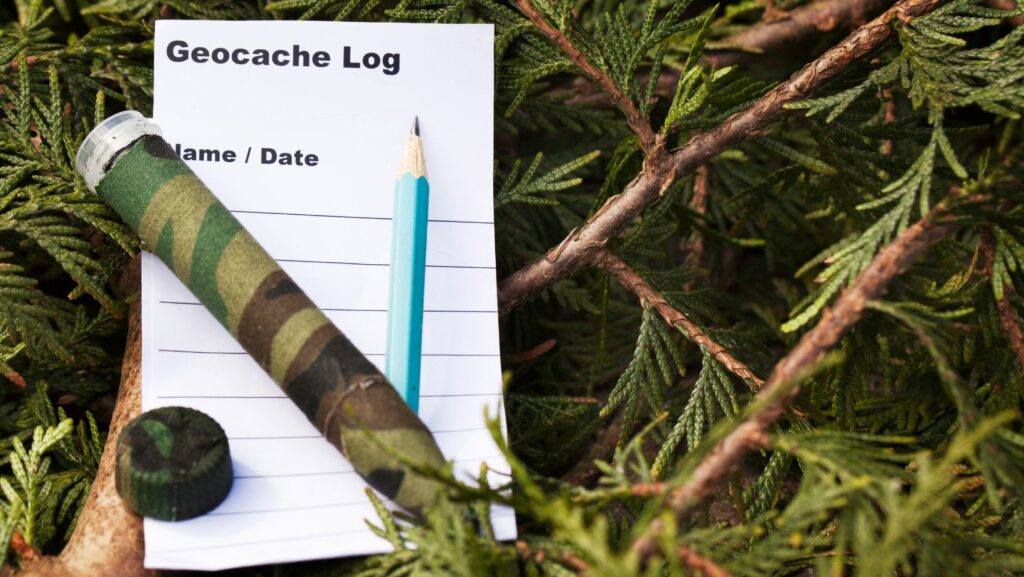Delving into the world of geocaching, it’s impossible to overlook the importance of log sheets. These humble pieces of paper are more than just a place to scribble your name. They’re the silent witnesses to every triumph, every discovery, and every shared adventure.
Geocaching Log Sheets
 Geocaching log sheets, indispensable tools in the geocaching world, authenticate a cacher’s presence at a specific geocache location. Crafted from weather-resistant material, these sheets become the sharable memento of your geocaching journey. Whether tucked inside a towering public monument’s geocache or a park’s hidden nano cache, log sheets record the “found it” moments and the dates attached to them. They allow cachers to leave their mark, branding their accomplishment in the geocaching world.
Geocaching log sheets, indispensable tools in the geocaching world, authenticate a cacher’s presence at a specific geocache location. Crafted from weather-resistant material, these sheets become the sharable memento of your geocaching journey. Whether tucked inside a towering public monument’s geocache or a park’s hidden nano cache, log sheets record the “found it” moments and the dates attached to them. They allow cachers to leave their mark, branding their accomplishment in the geocaching world.
Thanks to these sheets, the world witnesses the adventures you embark upon and conquistadors you become along the journey. Bear in mind, each log sheet varies in size and form, depending on the geocache size. For example, a micro cache would house a tiny rolled-up log sheet while a large cache could contain a logbook. Regardless, each encapsulates the thrill of finding a geocache, immortalizing your feats in the world of geocaching.
Types of Geocaching Log Sheets
Geocaching log sheets vary, adapting to meet unique needs sparked by cache size and location. There prominently exist three main types: micro, regular and large.
 Micro Log Sheets, often the size of a pencil lead, fit perfectly into tiny containers such as film canisters or nano caches. They’re typically composed of durable, waterproof material, include space for 50+ entries and may be tightly rolled for storage.
Micro Log Sheets, often the size of a pencil lead, fit perfectly into tiny containers such as film canisters or nano caches. They’re typically composed of durable, waterproof material, include space for 50+ entries and may be tightly rolled for storage.
Regular Log Sheets, usually the size of a small notebook, are designed for medium-sized geocaches like ammo cans or big Tupperware containers. They offer ample room for geocachers to document their findings, often with 500 or more entries, and are either bound or loose-leaf.
Lastly, incorporated into sizeable containers like ammo boxes, are Large Log Sheets. These sheets, often in the form of bound books, afford hundreds of geocachers enough room to detail their adventure, leave notes and can hold up to 1000+ records.
Each log sheet type caters to varying geocache sizes, ensuring every adventure gets logged, no matter the size of the cache.
How to Use Geocaching Log Sheets
In geocaching, having a log sheet and knowing how to use it, becomes part and parcel of a geocacher’s adventure toolset. When a specific geocache is located, the geocacher signs their name and date of find on the log sheet. Different types of log sheets as mentioned, Micro, Regular and Large, provide sections for these entries, depending on cache size.
 For a seamless geocaching experience, it’s important to carry a pen or pencil to make entries on the geocaching log sheets. In the event of multiple people discovering the cache, a queue format is adopted, ensuring each cacher gets their moment of accomplishment recorded. After signing, the geocachers replace the sheet back in the cache, exactly as they found it, preserving the adventure and discovery for subsequent participants.
For a seamless geocaching experience, it’s important to carry a pen or pencil to make entries on the geocaching log sheets. In the event of multiple people discovering the cache, a queue format is adopted, ensuring each cacher gets their moment of accomplishment recorded. After signing, the geocachers replace the sheet back in the cache, exactly as they found it, preserving the adventure and discovery for subsequent participants.
Practicing this discipline, geocachers not only confirm their finds, but also adhere to geocaching etiquettes, fostering a respectful and nourishing community.
Tips for Waterproofing and Durability
Geocaching log sheets, though minute, bear witness to persistent explorations and relentless enthusiasm. Continuous exposure to various elements degrades these paper trails, making their protection vital. Laminate the log sheets for a water-resistant variant. Opt for the ‘pouch method,’ encasing the sheet in a plastic zipper bag, a simple yet effective way. Better durability can be achieved by using plastic or Tyvek-based logbooks, known for their resistance to weather extremities.
Use permanent, waterproof pens when scribing your success. Prevent ink leakage by using ballpoint pens and avoiding gel pens. Maintain log sheets’ integrity; avoid over-stuffing the cache, which might cause accidental damage. Establish these habits to preserve your geocaching experience and enjoy an enduring trail of memories.

